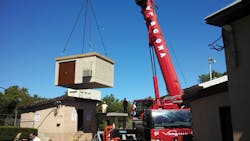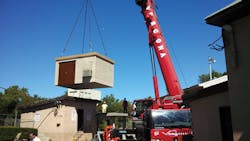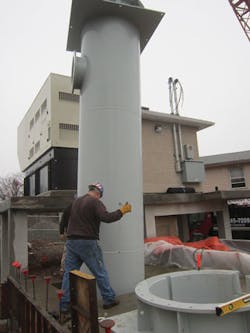Pump Station Retrofit Ends Stormwater Woes
By Steve London
For many years, residents of Lyndhurst, N.J., have been tormented by different types of flooding in several parts of town. Severe flooding occurred in 1999 as a result of Hurricane Floyd; a nor’easter in 2007 caused additional stormwater problems; in 2011, over 150 homes were flooded by Hurricane Irene; and the devastation Hurricane Sandy left in its path in 2012 is widely known. Residents were increasingly becoming concerned about their personal safety as well as property values.
The Lyndhurst Sewer Department is responsible for maintaining sewer mains, catch basins, manholes and sewer laterals. The township has a total of 990 catch basins, of which 180 are Bergen County’s and 45 are the State of New Jersey’s. There are 67 outfalls that help drain stormwater to the Hackensack and Passaic Rivers. The town also has three sanitary pumping stations and one stormwater pumping station.
Failing, old, long shaft pumps at Lyndhurst’s stormwater station were out on maintenance issues more often than they were in operation. Existing pumping equipment was noisy, prone to blockage by debris, and suffered from lube system problems. Removing the equipment for service was not only a challenge, it was also expensive. Reliability and performance issues seemed to rear their ugly heads during the most severe storm events and eventually became intolerable.
Key elements of the improvement of the township’s stormwater pumping station design included:
- Improving hydraulic inlet conditions in the clear well.
- Procuring robust replacement pumps that are compact and can handle the fibrous debris from a flooding river.
- Providing a system of monitoring and control of the pumping station, especially during times of inaccessibility.
The inlet conditions of a stormwater pumping station can be easily overlooked by a designer. The existing clear well included an uncontrolled inlet of stormwater flow, creating vortex conditions as well as pump submergence problems. The enhancement of the clear well addressed these conditions with the introduction of an inlet distribution channel, dividing walls at the pumps, and a prismatic splitter under each pump. These physical guides, along with the liquid level control program, addressed the vortex conditions as well as air entrainment during pump operations.
Pump replacement included a strong preference by the Lyndhurst officials for a submersible-pump solution. Lyndhurst DPW was already very familiar with Flygt’s reliability and the services provided by Pumping Services Inc., the pump manufacturer’s local representative. After careful review of the pump design and suitability for the desired flow conditions, Lyndhurst decided to go with mixed flow units. This type of pump offers a compact footprint that could be efficiently incorporated into the existing station clear well. In addition, the selected Flygt submersible mixed flow pump could operate in a less than ideal wet well layout. The selected pumps have the capability of handling difficult flood water debris - which often contains branches, leaves, weeds, trash, and sediment like sand, silt, mud, and soil - without clogging.
The previously installed pumps were conventional long shaft pumps that were placed into service in the 1950s. They were replaced with two 135-horsepower Flygt Model LL3602 submersible stormwater pumps. Now the stormwater station has a reliable capacity of 36,000 gpm.
“The new submersible mixed flow pumps have the same 135-HP motor rating as the old pumps, but these pumps indeed are working,” said project manager Patrick Carberry, P.E., from Neglia Engineering, the consultant on the project. “Even when the pump capacity rating (on paper) remains unchanged, the difference is visible. With the new Flygt pumps, area ponding is rapidly removed after heavy rain events.”
The new submersible pumps do not require a separate lubrication or cooling system and operate with a low operating sound level, minimal station superstructure, and simple pipe work.
In the past, the stormwater pumping station could only be controlled at the pumping station. During major flooding events, access to the pumping station was not possible. The retrofitted pumping station design now includes software that enables remote monitoring and control of essential equipment such as the pumps and generator. Monitoring and control is available at off-site locations, including Lyndhurst DPW headquarters, through a web-based iControl SCADA System manufactured by ICS Healy-Ruff, locally represented by Pumping Services Inc. Furthermore, the SCADA System allows monitoring of pump and generator operations, generator fuel levels, and even the water level of the Passaic River at the pumping station.
The new stormwater pumps saved the day. Flood ponding has been rapidly removed. Since the Flygt pumps were installed in 2014, residents have been able to rely on a stormwater pumping system that finally works.
The retrofitted stormwater station - which features a prefabricated elevated control building on a concrete platform, a generator, remote operation, and tide gates to protect the pumping station from high tides - is located in a park area south of the confluence of the Passaic and Third Rivers at Tontine and Riverside Avenues. This is a well-known tidal spot where many areas feature homes up on stilts.
“At the end of the day, Lyndhurst residents secured relief from chronic troublesome flooding,” said Township of Lyndhurst engineer Michael J. Neglia. “Lyndhurst gained a reliable, state-of-the-art stormwater pumping station featuring enhanced hydraulic performance - with new pumps, controllers, standby power system, SCADA, and communications systems. At the same time, Lyndhurst has reduced the operation and maintenance expenses of the stormwater pumping station.”
Matthew T. Ruzzo was the Superintendent of Lyndhurst DPW for almost 25 years, assuming the job in October 1988 and moving on to become Commissioner of Public Works in July 2012. He was succeeded by Richard C. Gress, the current Lyndhurst Superintendent of Public Works. Both men were tireless champions of rebuilding and maintaining the township’s infrastructure and today proudly point to the refurbished pumping station as one of their major achievements.
A lifelong resident of Lyndhurst, where he also raised his family, Commissioner Ruzzo concluded, “I can now sit in my home and watch the new pumping station operate on my computer. It is just amazing.”
About the Author: Steve London is president of Steven London Associates (Apollo Beach, Fla.). He has an extensive background as a writer and editor specific to municipal water treatment technologies. For the past 19 years, his company has developed application articles that highlight various solutions for water management professionals. London can be contacted at [email protected] or (813) 645-0209.



